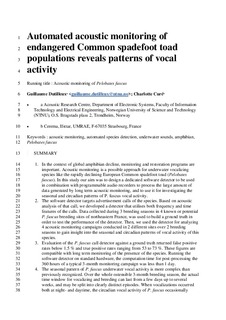| dc.description.abstract | In the context of global amphibian decline, monitoring and restoration programmes are important. Acoustic monitoring is a possible approach for underwater vocalising species like the rapidly declining European common spadefoot toad (Pelobates fuscus). In this study, our aim was to design a dedicated software detector to be used in combination with programmable audio recorders to process the large amount of data generated by long‐term acoustic monitoring and to use it for investigating the seasonal and circadian patterns of P. fuscus vocal activity.
The software detector targets advertisement calls of the species. Based on acoustic analysis of that call, we developed a detector that utilises both frequency and time features of the calls. Data collected during three breeding seasons in four known or potential P. fuscus breeding sites of north‐eastern France were used to build a ground truth in order to test the performance of the detector. Then, we used the detector for analysing four acoustic monitoring campaigns conducted in two different sites over two breeding seasons to gain insight into the seasonal and circadian patterns of vocal activity of this species.
Evaluation of the P. fuscus call detector against a ground truth returned false‐positive rates below 1.5% and true‐positive rates ranging from 53% to 73%. These figures are compatible with long‐term monitoring of the presence of the species. Running the software detector on standard hardware, the computation time for post‐processing the 360 hr of a typical 3‐month monitoring campaign was less than 1 day.
The seasonal pattern of P. fuscus underwater vocal activity is more complex than previously recognised. Over the whole ostensible 3‐month breeding season, the actual time window for vocalising and breeding can last from a few days up to several weeks and may be split into clearly distinct episodes. When vocalisations occurred at both night‐ and daytime, the circadian vocal activity of P. fuscus occasionally proceeded uninterrupted for 24 hr but usually a several hour lull occurred immediately prior to sunset. When vocalisations occurred at both night‐ and daytime, the vocal activity pattern followed a bimodal distribution with a nocturnal highest peak of activity and a second peak occurring in the morning.
Our results demonstrate that it is feasible to monitor presence of P. fuscus in north‐eastern France using a dedicated software detector combined with programmable audio recorders. Based on the outcomes of the detector applied to long‐term audio data sets, we reveal temporal patterns of the vocal activity of the species and subsequently provide recommendations for attended and unattended acoustic monitoring. | nb_NO |
